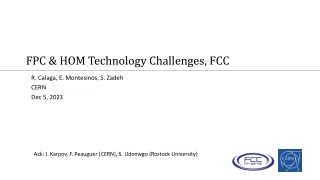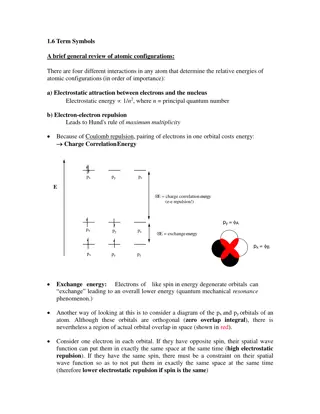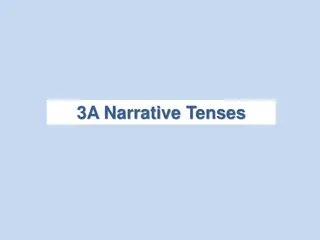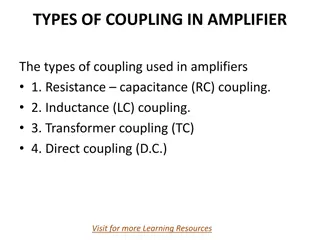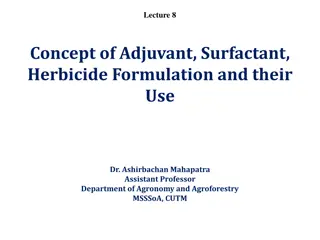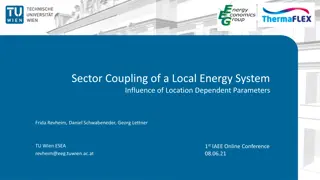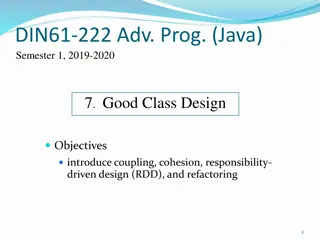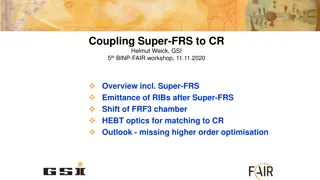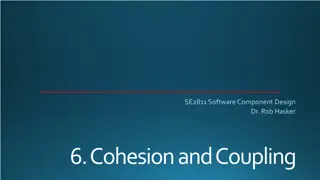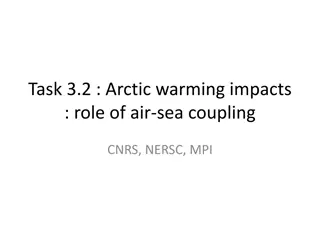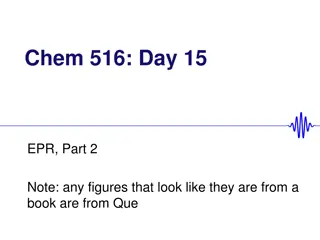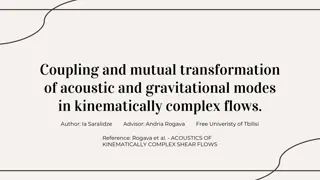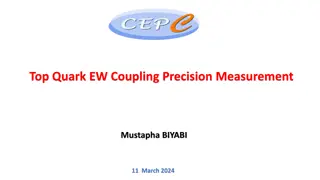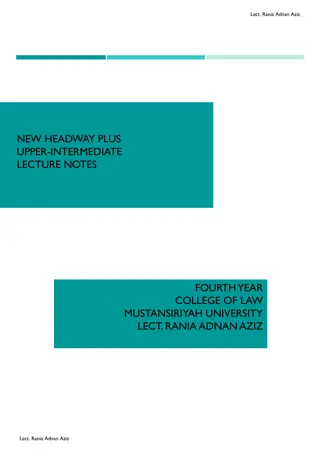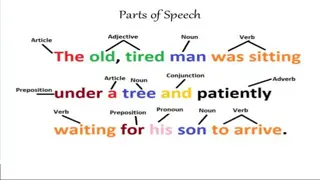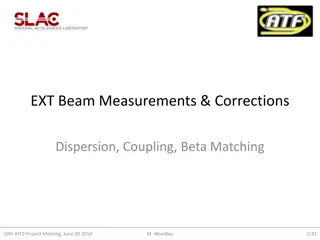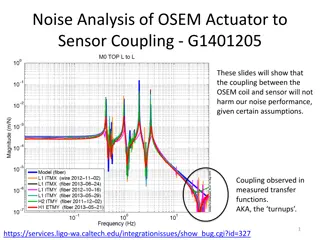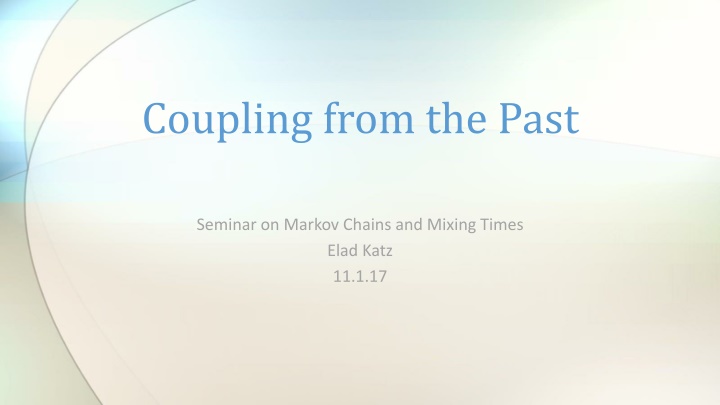
Seminar on Markov Chains and Mixing Times with Elad Katz
Delve into the fascinating world of Markov Chains and Mixing Times with Elad Katz in this insightful seminar. Explore topics like Coupling from the Past, Monotone CFTP, spin systems, and intrinsic randomness. Discover applications in various fields, including rhombus tilings in a hexagon and Gibbs sampling.
Download Presentation

Please find below an Image/Link to download the presentation.
The content on the website is provided AS IS for your information and personal use only. It may not be sold, licensed, or shared on other websites without obtaining consent from the author. If you encounter any issues during the download, it is possible that the publisher has removed the file from their server.
You are allowed to download the files provided on this website for personal or commercial use, subject to the condition that they are used lawfully. All files are the property of their respective owners.
The content on the website is provided AS IS for your information and personal use only. It may not be sold, licensed, or shared on other websites without obtaining consent from the author.
E N D
Presentation Transcript
Coupling from the Past Seminar on Markov Chains and Mixing Times Elad Katz 11.1.17
Monotone CFTP In the general setting, we have to keep track of | | mappings, which is usually infeasible. Monotone setting: A partial order such that x ? ? ?,?0 ? ?,?0 States 0, 1 such that 0 ? 1 for every ? . Now we only need to keep track of 2 mappings.
Monotone CFTP ? 1 do high 1 low 0 for ? = T to 1 do high ?(high, ??) low ?(low, ??) ? 2? until high = low return high
Example Consider the state space of the possible tilings of 60 rhombuses inside a regular hexagon. Define a partial order: ? ? when the cubes of ? are a subset of the cubes of ?. 0 1
Example Transitions: Uniformly select a site (vertex) Flip a coin (1) Heads: do nothing Tails: If possible, add / remove the cube there (2) Heads: If possible, add a cube there Tails: If possible, remove the cube there Same chain, but (1) will not work. 0.5
Example (2) 0.5 ? 1 ? 1 1 7 1 7 Definition: A spin system consists of the following: Set ? = ?:? {1, 1} Distribution ? on The system is attractive if the following holds: 5 14 5 14 ? 1 ? 1 ? 1 ? 1 0.2 0.2 1 3 1 3 1 6 1 6 ? 1 ? 1 0.1 ? ??=1,?=1 ? ??=1,?= 1 ? ??= 1,?=1 ? ??= 1,?= 1. For every ? and ?,? ?, Using Gibbs sampler, create a chain with stationary distribution ?: ?(??= ?(?)) ? ??=1+?(??= 1). 1 ? Move from ? to ??= ?(?) w. p.
Example (2) Use the following randomization: Uniformly select ? ?, ? 0,1 . ?(??=1) Move from ? to ??=1 if ? < ? ??=1+?(??= 1), otherwise switch to ??= 1. Claim: This randomization respects the following order: ? ? when ? ? ? ? for all ? ?. Proof: Let ? ?, and let ? ? be the selected spin. Attractiveness implies ? ??=1 ? ??=1 ? ??= 1. ? ??= 1 The order can only be violated if the transitions are ? ??=1 and ? ??= 1, which ?(??=1) ? ??=1+?(??= 1) ? < ? ??=1 ? ??=1 ? ??= 1< ? ??=1 ? ??= 1, a contradiction. ? ??=1+? ??= 1 implies
Intrinsic randomness matters What if we decided to discard ? and start fresh on every increment? 0.5 1 1 Pr 2 in step T= 1 = 0.5 1 2 0.5 2 2 1 1 1 1 Pr 2 in step T= 2 = 0.25 + 0.25 = 0.5 2 2 2 Pr 2 0.5 + 0.5 0.5 = 0.75
Time to coalescence Lemma: Let ?be the length of the longest totally ordered subset in and ? > 0. Pr(? > ?) ? ? ? ?,? ???, ???, (Recall: ? ? = max ??) Proof: ? be the states in time ?, beginning from 0 and 1. ? and ?1 Let ?0 Notice ???~???, . Let (?) be the maximal length of a monotone decreasing sequence beginning in ? . ? 1 if ?0 ? ?1 ? ?0 ?. ?1 ? ?1 ?= ?1 ? ?1 ? ? ?= Pr ?0 ? ?? 0,? = ? 0 + Pr ?0 ? ?? 1,? ?? 0,? ? 1 ? ?1 ? ?0 ? Pr ? > ? = Pr ?0 = ? ?? 1,? = ? ?1 ? ?? 1,? ?? 0,? ? ?0 ? ? ? ? ?? 1,? ?? 0,? ? ?? 1, ?? 0, ?? ? ? ?
Time to coalescence Theorem: Let ?be the length of the longest totally ordered subset in . 1 Pr ? > ????1 + log? 2 Proof: ? ???? 1 ? ?1+ ?2 ? ?1 ? ?2 ? ? 2?(?) Reminders: 4 1+log ? Pr ? > ????1 + log? ? ? ????1 + log? ? ? ???? 21+log ? 1 ? 1+log ? ? 2? ???? 2
Time to coalescence Lemma: Let ?1,?2 . Pr ? > ?1+ ?2 Pr ? > ?1 Pr ? > ?2 Proof: 0 Pr ? > ?1+ ?2 = Pr ? ?1 ?2 Pr ? ?1 is not constant and ? ?1 ?2 = Pr ? ?1 is not constant Pr ? ?1 ?2 = Pr ? > ?1 Pr ? > ?2 is not constant ?1 is not constant ?1 is not constant 0 0
Time to coalescence Lemma: Let ? > 0. ? ? ? 1 Pr(? > ?) Proof: ? ?+1 ? ? = ? ?(? = ?) = ? ? ? = ? ?=1 ?=0 ?=??+1 ? ? ? > ?? ?=0 ? ? ? ? > ?? 1 Pr(? > ?) ?=0
Time to coalescence Theorem: ? ? 2????(1 + log?) Proof: ????1 + log? Pr ? ????1 + log? ? ? ????1 + log? 1 1 = 2????1 + log? 2

